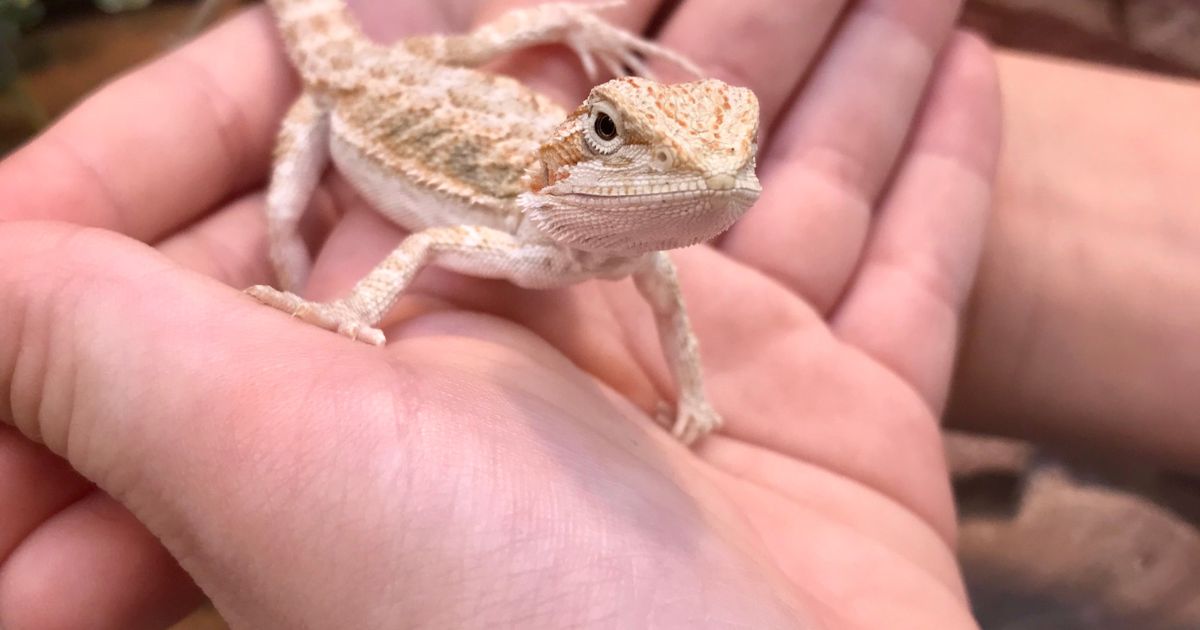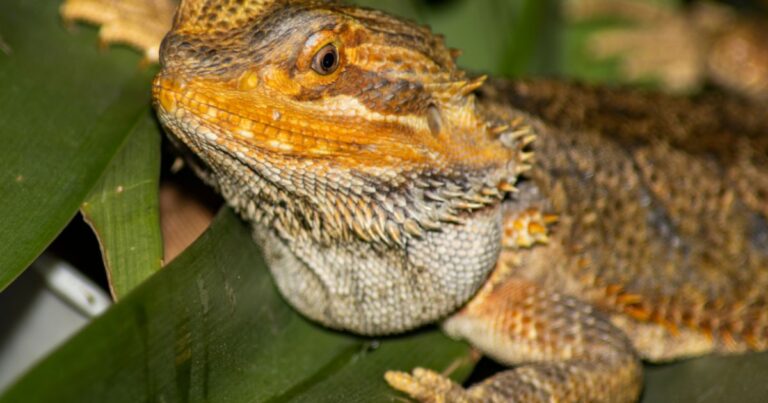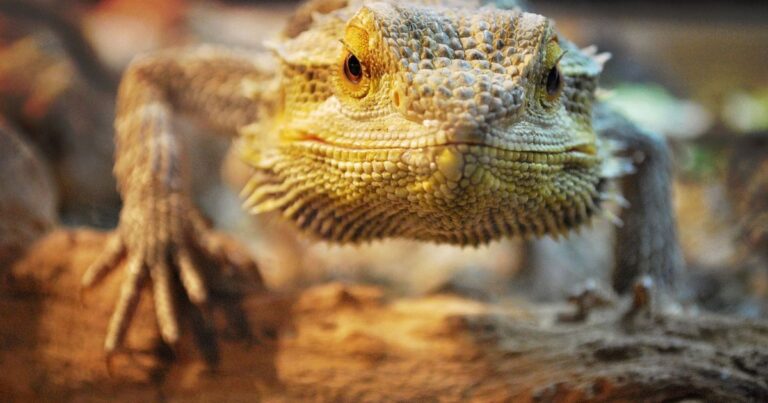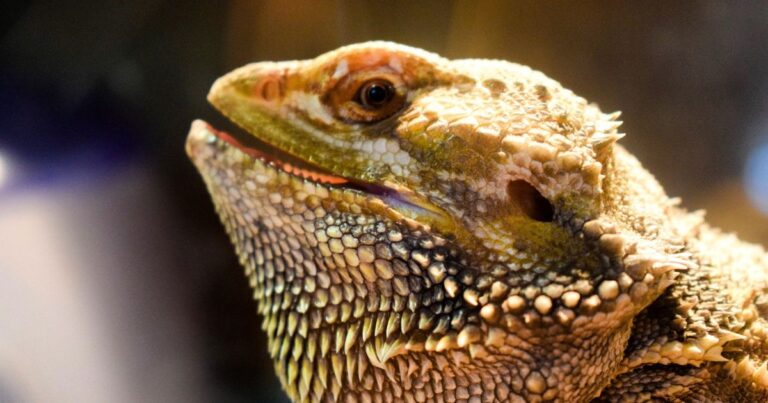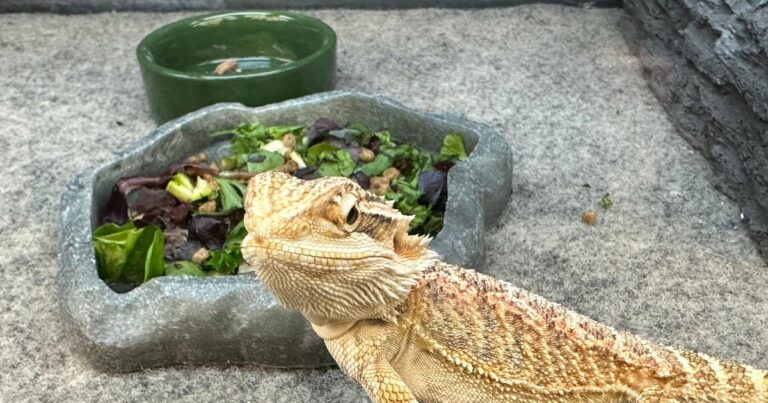Gentle Grasp: How to Handle a Bearded Dragon
Table of Contents
Disclaimer: This blog post is based on my personal experiences and research. It’s always best to consult with a professional or a vet for advice tailored to your specific bearded dragon.
Hey there, it’s Emily here, back with another exciting post about Bearded Dragon care. Today, we’re going to talk about something super important – how to handle a bearded dragon. Yup, you heard it right! We’re going to dive into the world of bearded dragon handling techniques, so buckle up and let’s get started!
Bearded Dragon Handling Techniques
So, you’ve got your bearded dragon, and you’re ready to start bonding. But wait! Before you start picking up your new friend, it’s crucial to know the right way to do it. Bearded dragons aren’t like your average pet; they need a gentle touch and a bit of know-how.
The first thing to remember is to approach your bearded dragon from the side, not from above. Why? Well, bearded dragons have a third eye (cool, right?) on top of their head that senses changes in light. If you swoop in from above, you might scare your dragon because they’ll think you’re a predator!
When you’re ready to pick up your bearded dragon, slide your hand under their belly, supporting their legs and tail. Never, and I mean NEVER, grab them by the tail. Their tails aren’t like lizards; they don’t grow back if they break off. So, always handle with care!
Bearded Dragon Handling Dos and Don’ts
| Do’s | Don’ts |
|---|---|
| Do wash your hands before and after handling | Don’t handle your bearded dragon right after feeding |
| Do approach your bearded dragon from the side | Don’t grab your bearded dragon from above |
| Do support your bearded dragon’s body and tail | Don’t hold your bearded dragon by the tail |
| Do handle your bearded dragon in a quiet, calm environment | Don’t handle your bearded dragon in a loud or chaotic environment |
| Do give your bearded dragon time to get used to handling | Don’t force your bearded dragon to be handled if they’re clearly stressed or uncomfortable |
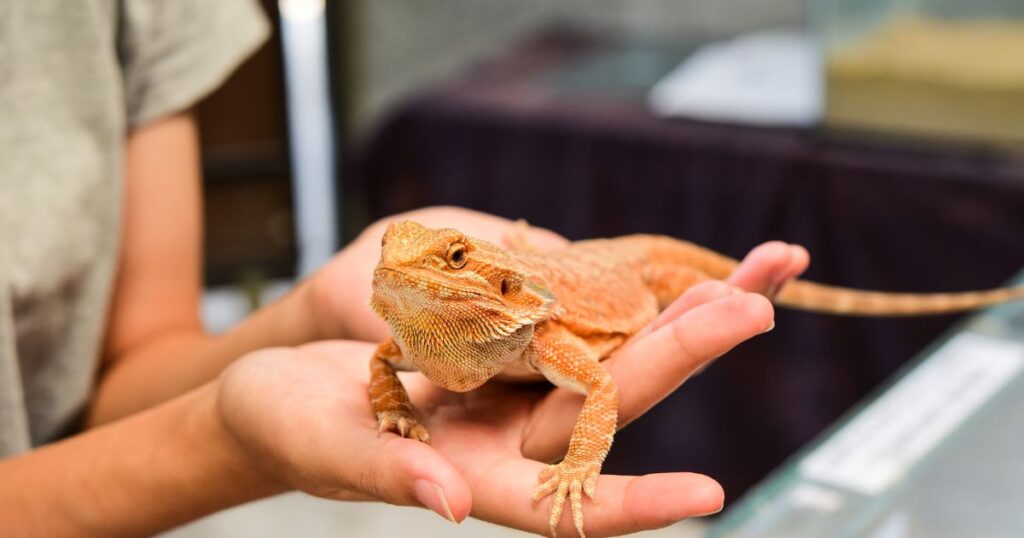
How to Handle a Bearded Dragon
Now that you’ve safely picked up your bearded dragon, let’s talk about how to handle a bearded dragon. Holding a bearded dragon isn’t too tricky, but there are a few things to keep in mind.
First, always support their body, especially their belly and tail. Imagine you’re a living, moving branch for them to sit on. Bearded dragons love to climb, so they’ll feel right at home!
Second, keep your movements slow and steady. Quick movements can startle your bearded dragon, and we don’t want that. Remember, we’re trying to build trust here!
Lastly, don’t squeeze or hold your bearded dragon too tightly. We want them to feel secure, not squished. A gentle but firm hold is just right.
Signs Your Bearded Dragon is Comfortable with Handling
- Your bearded dragon is calm and relaxed in your hands
- They don’t try to escape or run away
- They don’t puff up their beard or open their mouth
- They don’t whip their tail
- They may even close their eyes or fall asleep
Bearded Dragon Interaction
Handling is a big part of interacting with your bearded dragon. It’s a great way to bond and build trust. But remember, every bearded dragon is different. Some might love being handled right away, while others might need a little more time to get used to it.
Start with short handling sessions, maybe just a few minutes at a time. As your bearded dragon gets more comfortable, you can gradually increase this time. Patience is key when learning how to handle a bearded dragon, guys!
And don’t forget to wash your hands before and after handling your bearded dragon. We want to keep our dragons healthy, and good hygiene is a big part of that!
Handling your bearded dragon can be a wonderful way to bond with them and build trust. Remember, patience and gentleness are key. With time, your bearded dragon can become comfortable with handling and even come to enjoy it.”

Handling Bearded Dragon for Beginners
If you’re a beginner, handling a bearded dragon might seem a bit scary. But don’t worry, we’ve all been there. With a bit of practice and these tips, you’ll be a pro in no time!
First, always supervise children when they’re handling a bearded dragon. Kids can get a bit excited, and we want to make sure both the child and the bearded dragon are safe.
Second, make sure your bearded dragon is awake and alert before you try to handle them. Trying to pick up a sleeping dragon is a surefire way to get a grumpy response!
Lastly, if your bearded dragon seems stressed or scared, give them some space. It’s okay to take a break and try again later. Remember, building trust takes time!
Bearded Dragon Handling Tips
Now that we’ve covered the basics, let’s dive into some extra bearded dragon handling tips. These will help make your handling sessions smoother and more enjoyable for both you and your dragon.
First, try to handle your bearded dragon in a quiet, calm environment. Loud noises or sudden movements can startle them.
Second, pay attention to your bearded dragon’s body language. If they’re puffing up their beard or opening their mouth, they might be feeling threatened. Give them some space and try again later.
Lastly, remember to enjoy this time with your bearded dragon! Handling sessions are a great way to bond and get to know each other better.
Comfortable Handling for Bearded Dragons
We’ve talked a lot about how to handle a bearded dragon, but what about making sure they’re comfortable? After all, we want our scaly friends to enjoy our cuddle sessions as much as we do!
First, make sure your hands are warm before you pick up your bearded dragon. Cold hands can be a bit of a shock for them.
Second, try to handle your bearded dragon at their level. This means sitting or lying down on the floor during your handling sessions. This can help your bearded dragon feel more secure.
Lastly, give your bearded dragon a chance to explore. Let them crawl on your arms, shoulders, or even your head! Just make sure to keep a close eye on them to prevent any accidental falls.
Bearded Dragon Handling Etiquette
Just like there’s etiquette for eating dinner or going to the movies, there’s also etiquette for handling bearded dragons. Here are some do’s and don’ts to keep in mind.
Do: Always supervise children and other pets during handling sessions. We want to keep everyone safe!
Don’t: Never wake up your bearded dragon to handle them. Let sleeping dragons lie, as they say!
Do: Always wash your hands before and after handling your bearded dragon. This helps keep them healthy.
Don’t: Never grab your bearded dragon by the tail. Their tails are fragile and can easily break.
“Remember, every bearded dragon is unique. What works for one bearded dragon may not work for another. The most important thing is to pay attention to your bearded dragon’s signals and adjust your handling techniques as needed.”
Bearded Dragon Socialization
How to handle a bearded dragon is a big part of socializing your bearded dragon. It helps them get used to being around people and can even help them feel more comfortable in their new home.
Start by handling your bearded dragon for a few minutes each day. As they get more comfortable, you can gradually increase this time.
Remember, every bearded dragon is different. Some might love being handled right away, while others might need a little more time to get used to it. Always respect your bearded dragon’s comfort level and never force them to be handled if they don’t want to be.
Bearded Dragon Stress Reduction During Handling
Handling can be stressful for bearded dragons, especially if they’re not used to it. But don’t worry, there are ways to reduce stress and make handling a positive experience for your dragon.
First, always approach your bearded dragon slowly and calmly. Fast movements can startle them.
Second, try to handle your bearded dragon at the same time each day. This can help them get used to a routine and make handling a normal part of their day.
Lastly, give your bearded dragon plenty of breaks during handling sessions. If they seem stressed or scared, put them back in their enclosure and try again later.
Common Bearded Dragon Body Language During Handling
| Body Language | What It Means |
|---|---|
| Relaxed body | Your bearded dragon is comfortable |
| Puffed up beard | Your bearded dragon is stressed or scared |
| Open mouth | Your bearded dragon is threatened |
| Trying to escape | Your bearded dragon is uncomfortable |
| Closing eyes | Your bearded dragon is relaxed and trusts you |
And there you have it, folks! A comprehensive guide on how to handle a bearded dragon. Remember, handling is a great way to bond with your bearded dragon and help them feel more comfortable in their new home. But like anything, it takes practice and patience. So take your time, be gentle, and before you know it, you’ll be a bearded dragon handling pro!
I hope you found this post helpful. If you have any questions or want to share your own bearded dragon handling tips, feel free to leave a comment. I’d love to hear from you!
Until next time, keep being awesome, dragon lovers!
Always remember that every bearded dragon is unique. What works for one might not work for another. So, always pay attention to your bearded dragon’s body language and comfort level. And most importantly, enjoy your time with your scaly friend!
I hope this post has given you some helpful tips on how to handle a bearded dragon. Remember, patience and gentleness are key. Happy handling, and until next time, keep exploring the amazing world of bearded dragons!
Frequently Asked Questions on How to Handle a Bearded Dragon
How often should I handle my bearded dragon?
It’s recommended to handle your bearded dragon for a few minutes each day, especially when they’re new to your home. This helps them get used to you and their new environment. As they get more comfortable, you can gradually increase this time.
My bearded dragon seems scared when I try to handle them. What should I do?
If your bearded dragon seems scared, give them some space and try again later. It’s important to move at a pace that’s comfortable for your bearded dragon. Over time, they should start to feel more comfortable with being handled.
Can children handle bearded dragons?
Children can handle bearded dragons, but they should always be supervised to ensure the safety of both the child and the bearded dragon. Teach children to be gentle and respectful when handling bearded dragons.
Can I handle my bearded dragon right after I bring them home?
It’s usually best to give your bearded dragon a few days to adjust to their new home before you start handling them. This can help reduce stress and make the transition easier for them.
How can I tell if my bearded dragon is stressed during handling?
Signs of stress in bearded dragons can include puffing up their beard, opening their mouth, or trying to escape. If your bearded dragon shows any of these signs, it’s best to give them a break and try again later.
Can I handle my bearded dragon outside?
You can handle your bearded dragon outside, but always keep a close eye on them to prevent them from escaping or getting hurt. Also, make sure the outdoor temperature is suitable for your bearded dragon.
What should I do if my bearded dragon bites me while handling?
Bearded dragon bites are usually not serious, but they can be surprising. If your bearded dragon bites you, it’s important not to drop them or react in a way that could hurt them. Instead, gently put them back in their enclosure and give them some space. Over time, as your bearded dragon gets more comfortable with handling, biting should become less of an issue.
Can I handle my bearded dragon during brumation?
It’s usually best to let sleeping dragons lie. If your bearded dragon is brumating, it’s best to minimize handling to avoid disturbing them.
Sources
- Using Google Trends to Determine Current, Past, and Future Trends in the Reptile Pet Trade by Jose W. Valdez. This study examines the popularity of different reptiles in the pet trade, including bearded dragons. It found that the most popular species were docile, medium-sized, easy to handle, and had relatively simple requirements, which aligns with the information in this blog post.
Please note that while these sources provide valuable information, it’s always important to consult with a professional or experienced bearded dragon owner for specific advice on handling and care.
This post belongs to my series on Bearded Dragon Care
Also check out From Bugs to Berries: Designing a Balanced Bearded Dragon Diet
